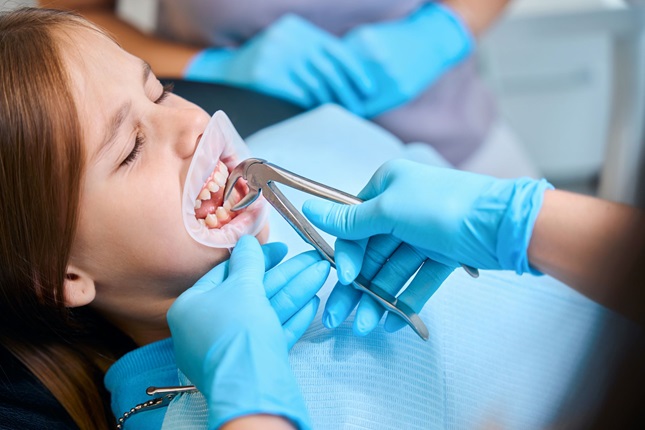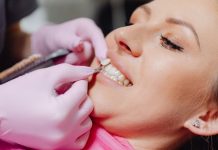A tooth extraction is a common dental procedure, but proper aftercare ensures a smooth recovery. Parents, especially moms, typically juggle caring for their children while managing their post-extraction needs. Knowing what to avoid can prevent complications like infection, dry socket, or prolonged healing.
This guide covers the key mistakes to avoid after a tooth extraction, helping moms and their recovering children confidently navigate the healing process.
Avoid Disturbing the Blood Clot
The blood clot that forms in the extraction site is essential for healing. Dislodging it can lead to a painful condition called a dry socket. To prevent this, it’s important to do the following:
- No Straws or Spitting: Using a straw can create suction in the mouth, which can dislodge the delicate blood clot protecting the extraction site. Similarly, forceful spitting can generate pressure that may loosen the clot, leading to a painful dry socket. For the first 24–48 hours, patients should sip liquids directly from a cup and let saliva drain naturally. This precaution can ensure proper healing and minimize complications.
- Limit Talking and Facial Movements: Excessive talking, chewing, or facial expressions can disturb the extraction site. The more the area is agitated, the higher the risk of reopening the wound or displacing the clot. Keeping conversations brief and avoiding unnecessary jaw activity for the first day can also help stabilize the clot and promote faster recovery.
- Avoid Poking the Area: Curious fingers, tongue prodding, or foreign objects like toothpicks can accidentally dislodge blood clots or introduce bacteria, increasing infection risk. Children may need supervision to prevent them from touching the area. Moreover, letting the extraction site heal undisturbed is crucial as any interference can delay recovery and cause unnecessary pain or complications.
Children, in particular, may need gentle reminders to leave the area alone. However, for moms wanting to learn more information about some aftercare tips for dental procedures, including tooth extraction, consulting a trusted dentist in their area would be a great start.
Skip Strenuous Activity
Physical exertion increases blood pressure, which can lead to bleeding at the extraction site. For at least 48 hours, moms should consider the following tips after their children’s tooth extraction:
Avoiding Heavy Lifting, Running, or Intense Workouts
As mentioned, vigorous physical activity can increase blood pressure, triggering bleeding at the extraction site and disrupting the healing process. Strenuous exercise can also raise the risk of dislodging the blood clot, potentially leading to dry socket. As such, patients should avoid heavy exertion, sports, and high-impact movements for at least 48–72 hours post-extraction. Light walking is also acceptable, but anything that causes strain should be postponed until proper healing begins.
Encouraging Rest and Light Activities for Kids Who’ve Had an Extraction
Children may feel restless after a tooth extraction, but excessive movement can hinder their recovery. Instead of active play, moms should encourage their children to do calm activities like reading, coloring, or watching movies. They should also ensure their patients avoid playgrounds, running, or roughhousing for at least two days. Keeping kids relaxed can also prevent accidental trauma to the extraction site and ensure the blood clot remains intact, reducing pain and speeding up the healing process.
Keeping the Head Elevated to Minimize Swelling
Lying flat can increase blood flow to the extraction site, worsening swelling and discomfort. For the first 24–48 hours, patients, especially children, should sleep with their head propped up on an extra pillow. During the day, sitting upright rather than reclining can help reduce inflammation. Elevating the head can discourage excess bleeding and promote proper clotting, contributing to a smoother, more comfortable recovery period.
Don’t Ignore Dietary Restrictions
Eating the wrong foods can irritate the extraction site or trap debris, increasing infection risk. Hence, the first few days after a tooth extraction require careful food choices to prevent irritation, infection, or damage to the healing socket. For instance, crunchy or hard foods like chips, nuts, and popcorn can get lodged in the extraction site or scrape the wound, delaying recovery. Spicy or acidic foods, including citrus fruits and hot sauces, may cause stinging pain and inflammation. Sticky or chewy foods such as caramel and gum can also pull out the blood clot, leading to dry socket, a painful complication that disrupts healing.
On the other hand, soft, easy-to-eat foods are ideal for the first 48–72 hours. Soft, cool foods like yogurt, pudding, and applesauce can soothe the area without chewing. Lukewarm soups can provide nourishment without risking clot dislodgment. Smoothies (consumed with a spoon, not a straw) can offer nutrients while avoiding suction risks.
Lastly, moms should closely monitor their child’s diet to ensure only safe, healing-friendly foods are consumed during recovery. Proper nutrition can help support faster healing while minimizing discomfort.
Avoid Smoking and Alcohol
Smoking can significantly impair healing by constricting blood vessels, reducing oxygen flow to the extraction site, and introducing harmful toxins that increase infection risk. The suction motion while smoking also raises the likelihood of dislodging the blood clot, leading to dry socket—a painful complication. Patients should abstain from smoking for at least 72 hours, with longer cessation being ideal for optimal recovery.
Additionally, alcohol consumption should be avoided for 24–48 hours as it can interfere with prescribed medications, thin the blood (potentially causing bleeding), and irritate the wound. This is especially crucial when taking painkillers, as mixing alcohol with certain medications can be dangerous. Even vaping poses similar risks due to nicotine’s effects on circulation and the suction motion involved. Teens and adults should be strongly cautioned against all forms of smoking and vaping during the critical healing period. By following these guidelines, moms can ensure proper recovery and minimize complications.
Don’t Neglect Oral Hygiene (But Be Gentle)
Keeping the mouth clean is important, but aggressive brushing or rinsing can harm the extraction site. Here’s how moms can avoid neglecting oral hygiene:
Rinsing Gently with Saltwater
After the first 24 hours post-extraction, gentle saltwater rinses can aid healing by keeping the area clean without disrupting the blood clot. Moms are advised to mix ½ teaspoon of salt in warm water and swish carefully, letting the liquid flow passively without vigorous motion. This can help reduce bacteria and soothe irritation while preventing infection. They should also rinse 2-3 times daily, especially after meals, but avoid harsh gargling or spitting forcefully to protect the sensitive clot.
Brushing Carefully, Avoiding the Extraction Area
Moms should help their recovering children to maintain oral hygiene by brushing normally but steering clear of the extraction site for at least 3 days. They should use a soft-bristled toothbrush and gentle strokes around adjacent teeth to prevent disturbing the healing socket. After 72 hours, they may carefully clean near the area with light, downward motions. Moms are also advised to never poke or scrub the wound, as this can dislodge the clot or damage delicate tissue, delaying recovery.
Skip Hot Beverages and Foods
Exposure to heat can pose significant risks during the initial healing phase after a tooth extraction. Elevated temperatures can dissolve the protective blood clot in the socket, potentially leading to painful dry socket. Heat also dilates blood vessels, increasing swelling and discomfort at the surgical site. For the critical first 24 hours, patients should strictly avoid hot drinks like coffee and tea and steaming soups. Instead, they should opt for lukewarm or cool alternatives, such as room temperature broths, chilled yogurt, or ice cream (without crunchy mix-ins) to provide safe nourishment while protecting the healing wound. This precaution can help maintain the integrity of the blood clot and minimize post-operative inflammation for smoother recovery.
Also, the temperature restriction serves dual purposes: protecting delicate clot formation while preventing additional trauma to sensitive tissues. As healing progresses after the first day, moms should gradually reintroduce warmer items, testing carefully for comfort. Remember that even warm (not hot) foods should be consumed cautiously until the extraction site shows signs of stable healing, typically after 3-5 days.
Don’t Take Aspirin for Pain Relief
Aspirin is blood thinner and can increase bleeding risk. Instead, moms should consider the following:
Using Prescribed or OTC Pain Relievers Like Acetaminophen
After an extraction, managing discomfort is crucial for recovery. While aspirin can increase bleeding risk, acetaminophen (Tylenol) is a safer alternative that effectively reduces pain without interfering with clotting. It’s best for mothers to always use medications as directed by their dentist or physician. For stronger pain, prescribed analgesics may be recommended but avoid self-medicating with unsuitable painkillers that could complicate healing.
Following Dosage Instructions Carefully, Especially for Children
Precise medication dosing is vital for safety and effectiveness. Children require age-appropriate doses based on weight, not guesswork. Therefore, moms should always use the measuring device provided with liquid medications, never household spoons. They should also strictly adhere to timing between doses to prevent accidental overdose. Consulting the dentist or pediatrician if unsure about proper administration is essential as improper dosing can lead to serious health complications.
Avoid Touching the Extraction Site
The natural curiosity of children and even adults typically lead to the urge to poke or probe the extraction area with fingers or tongue. However, this introduces harmful bacteria into the vulnerable wound and can physically disrupt the delicate healing process. Even gentle contact may dislodge the protective blood clot, leading to painful complications like dry socket or infection. Mothers should also educate children about the importance of leaving the area undisturbed while supervising younger patients who may not fully understand these risks.
When checking the extraction site for swelling or bleeding, mothers are encouraged to always wash their hands thoroughly with antibacterial soap first. They should apply light pressure with sterile gauze when minor bleeding occurs rather than using tissues or cotton that might leave fibers in the wound. These precautions can minimize bacterial exposure while allowing proper monitoring of the healing progress.
Don’t Skip Follow-Up Appointments
Post-extraction check-ups allow dentists to monitor healing progress and identify potential issues before they escalate. Professionals can detect early infection signs, improper clotting, or dry socket formation that patients might miss. These appointments can also provide an opportunity to remove any stubborn food debris trapped near the surgical site and receive personalized advice for ongoing care based on the patients’ unique healing process.
Between visits, mothers should watch for abnormal symptoms, such as the following:
- Throbbing pain worsening after 3 days
- Increasing swelling after 48 hours
- Foul taste/smell indicating possible infection
- Visible bone in the socket
Prompt reporting of these symptoms to the dentist can prevent serious complications and ensure proper intervention. Mothers should particularly monitor children who may not articulate their discomfort effectively. Establishing open communication with the dental provider can ensure optimal recovery outcomes.
Final Thoughts
Recovering from a tooth extraction requires patience and discipline. Avoiding these common mistakes can help moms ensure a smoother healing process for their children. Proper aftercare can help reduce pain, prevent complications, and promote faster recovery.
By following these guidelines, moms can confidently manage post-extraction care and help their children heal comfortably.





